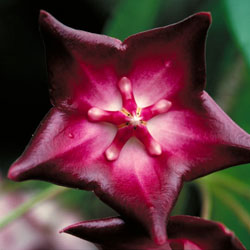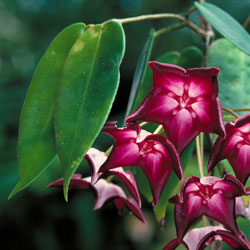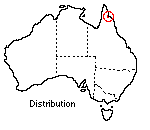Hoya macgillivrayi
 |
 |
Hoya, a member of the Asclepiadaceae family, is a large genus with over 200 species of milky-sapped, evergreen climbers native to Malaysia, India, China and the tropical regions of Australia. Many are widely cultivated as ornamental plants. In Australia at least seven species are found throughout tropical and subtropical regions. Many hybrids and selected forms have been developed for horticulture.
One of the most spectacular species in the Australian flora is Hoya macgillivrayi, a strong succulent climber endemic to the Iron Range - McIlwraith Range area of Cape York Peninsula. In its natural habitat it climbs to reach the light in the canopy above and thrives in the strong light of the tree tops or along open creeks.
 Hoya
macgillivrayi is a fast-growing root climber and twiner with thick, oval,
pointed leaves which are light green and set opposite each other on the twining
stems. The flowers are up to 6 cm wide on long stalks and are borne in umbels of six to ten flowers radiating from a central axis. A rich burgundy in colour,
they are made up of five sepals and five waxy petals. The stamens are enclosed
by a fleshy appendage called a corona. The fruit matures to a pair of pendulous follicles up to 25 cm long which split open when ripe to release the flattish wind-distributed
seeds.
Hoya
macgillivrayi is a fast-growing root climber and twiner with thick, oval,
pointed leaves which are light green and set opposite each other on the twining
stems. The flowers are up to 6 cm wide on long stalks and are borne in umbels of six to ten flowers radiating from a central axis. A rich burgundy in colour,
they are made up of five sepals and five waxy petals. The stamens are enclosed
by a fleshy appendage called a corona. The fruit matures to a pair of pendulous follicles up to 25 cm long which split open when ripe to release the flattish wind-distributed
seeds.
This decorative plant can be grown in a sheltered, semi-shaded position in warm humid areas where it can be trained against a wall or framework. In colder climates it can be cultivated as a glasshouse plant or as a container plant for the patio or indoors. A cylindrical wire frame around which the vine can be twined is effective.
This plant will not tolerate stagnant soil conditions and a loose, friable, peaty soil mixture with good drainage is essential. During winter the plant should be kept dry. Container plants can be grown in a mixture of peat and sand or sandy loam to which a slow release fertiliser and a little lime has been added. For maximum flowering, plants should not be overfed. An application of a slow release fertiliser at nine-monthly intervals is adequate.
Plants in containers perform better when root-bound and should not be transferred to a too-large pot when re-potting. The use of terracotta pots provides a simple method of repotting. The pot can be cracked all over with a hammer and the plant with its cracked container can be repotted into a larger pot lined with fresh soil mix. This allows the roots to penetrate into the new mix while the root system is held firmly together by the cracked pot.
Seed is slow to germinate but propagation is readily carried out from cuttings. Cuttings can be taken throughout the year and should have at least three nodes. The leaves should be trimmed to half their length and the base of the cutting dipped in a root hormone solution prior to planting. Cuttings take three to four weeks to develop roots.
Text by Effie Mullins, ANBG (1986)
Name meaning: Hoya macgillivrayiHoya - in honour of Thomas Hoy (f l.1788-1809), gardener at Syon House, Isleworth, Middlesex, seat of the Duke of Northumberland; macgillivrayi - in honour of Dr William David Kerr Macgillivray (1867-1933), a physician and eminent ornithologist and naturalist who carried out several important expeditions to north Queensland, and who collected the type specimen. |
![An Australian Government Initiative [logo]](/images/austgovt_brown_90px.gif)

